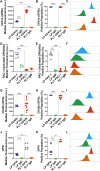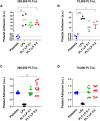Lyophilized platelets inhibit platelet aggregation with simultaneous paradoxical promotion of platelet adhesion
- PMID: 36061448
- PMCID: PMC9437314
- DOI: 10.3389/fbioe.2022.941817
Lyophilized platelets inhibit platelet aggregation with simultaneous paradoxical promotion of platelet adhesion
Abstract
Lyophilized platelets have been explored as a potential hemostatic agent due to their long-term ambient storage capabilities that make them readily available in various scenarios. Additionally, their high biocompatibility and the key role of platelet interactions in various clinical conditions make them a promising platform for drug delivery. To explore these applications and for wider clinical deployment, the interactions between lyophilized platelets and fresh platelets must be examined. This project characterized receptor expression on the lyophilized platelet surface and their ability to bind fibrinogen using flow cytometry. The effect of lyophilized platelets on aggregation of unaltered platelets was assessed using light transmission aggregometry while the effect on adhesion was evaluated using static and microfluidic assays. Lyophilized platelets maintained significant levels of GPIIb and GPVI receptors on their surface, though the expression was reduced from fresh platelets. Additionally, lyophilized platelets maintained GPIb expression similar to fresh platelets. Furthermore, 15.8% of the lyophilized platelets exhibited the active conformation of the GPIIb/IIIa receptor, indicating a significant increase over fresh platelets. Lyophilized platelets also exhibited an increase in exposed phosphatidylserine and fibrinogen binding. Despite the effect of lyophilized platelets in promoting the adhesion of fresh platelets on a collagen-coated surface, their net effect was inhibitory on platelet aggregation. This study demonstrates that lyophilized platelets can have paradoxical effects on platelet adhesion and aggregation, which could have an impact for clinical applications. Detailed characterization and engineering of these effects will be important for their continued development as a drug delivery platform.
Keywords: blood product; lyophilized platelets; platelet adhesion; platelet aggregation; platelets.
Copyright © 2022 Schnoor and Papa.
Conflict of interest statement
The authors declare that the research was conducted in the absence of any commercial or financial relationships that could be construed as a potential conflict of interest.
Figures




References
-
- Alemany M., Hernandez M. R., Bozzo J., Galan A. M., Reverter J. C., Mazzara R., et al. (1997). In vitro evaluation of the hemostatic effectiveness of non viable platelet preparations: studies with frozen-thawed, sonicated or lyophilized platelets. Vox Sang. 73, 36–42. 10.1046/j.1423-0410.1997.7310036.x - DOI - PubMed
LinkOut - more resources
Full Text Sources

